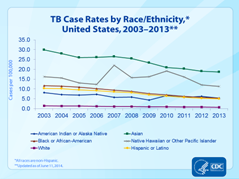|
During
Asian American and Pacific Islander Heritage Month, we highlight opportunities
to address issues that affect the health of Asian American and Pacific Islander
women in our communities.
Prevent
Tuberculosis in Asian American and Pacific Islander Women 
Slide set
- Tuberculosis in the United States, 2013
Among
all tuberculosis (TB) cases in the United States, racial/ethnic minorities
continue to be disproportionately affected by TB. Asians continue to be the
racial/ethnic group with the largest number of TB cases. Compared with
non-Hispanic whites, the TB rate among Asians in 2013 was 26 times higher. In
2013: - 1,318
cases of TB disease were diagnosed in the United States in Asian
females (all ages), for a rate of 15.6/100,000; and
- 33
cases of TB disease were diagnosed in the U.S. in Native Hawaiian or
other Pacific Islander females (all ages), for a rate of 12.5/100,000.
- In
comparison, 481 cases of TB disease were diagnosed in the United States in
white females (all ages), for a rate of 0.5/100,000 the same year.
- The
TB case rate for Asians in the United States remained over three times the
rate for Hispanics or blacks or African Americans.
People
with TB disease are sick. They may also be able to spread the bacteria to other
people. TB can be prevented, treated, and cured, but early
detection and proper treatment are needed.
What
more can we do? - If
you think you have been exposed to someone with TB disease, you should contact your health provider or local health
department about getting a TB skin test or a special TB blood test.
- People with HIV are at high risk for getting TB disease if they are
exposed and become infected. If you have HIV, get tested for TB infection;
if you are found to have TB infection, you can take treatment to keep from
getting TB disease.
- Untreated
TB disease represents a greater hazard to a pregnant woman and her fetus than does its treatment. Treatment of
pregnant women should be initiated whenever the probability of TB is
moderate to high.
To achieve TB elimination,
intensified efforts are needed to address the persistent disparities that exist
between U.S.–born and foreign-born persons, and between whites and minorities
in the United States. Improved awareness, testing, and treatment of latent
infection and TB disease in minorities and foreign-born populations is
essential to these efforts.
|

